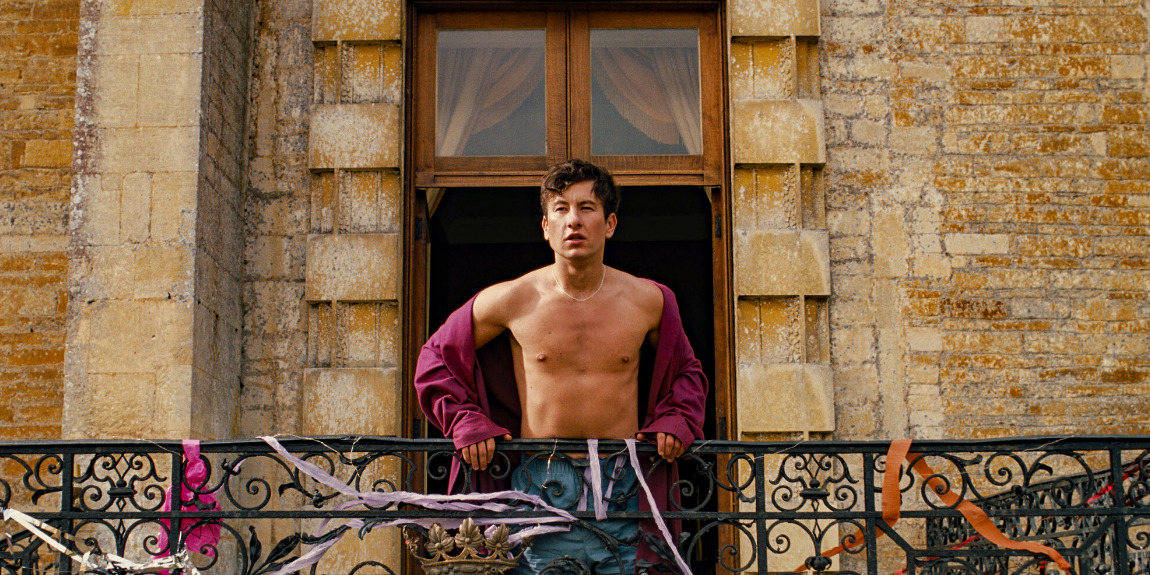‘Saltburn,’ a Gothic drama film rich in vivid imagery— both visual and thematic— delves into the exploration of provocative ideas such as desire, envy, and infatuation. Oliver Quick, an Oxford alumnus, helms the narrative as the protagonist who develops an obsession with Felix Catton, an enticing, wealthy young man who lives a glamorous life. Likewise, Felix takes a liking to Oliver after learning about his unpleasant background and invites him to stay at his family’s grand estate, Saltburn. From there emerges a fascinating tale of voyeuristic titillation and worse, as the film follows Oliver’s time with Felix’s family when their summer descends into slow-brewing madness.
A notable entry into the subgenre, “Something Happens in a Country House One Summer,” one of Emerald Fennell the writer/director’s self-proclaimed favorite genres of all time, ‘Salburnt,’ charts a story defined by its chaotic and concerningly compelling characters. Among this cast of characters, populated by Felix’s family, Elspeth, Farleigh, and Venetia, stands the titular non-human character itself, the Saltburn Estate. Thus, the house’s towering presence, compatible with its owners, The Catton family, compels viewers to wonder about the connection between these elements and reality.
The Saltburn Estate, a Monument Of Desire
No, The Saltburn Estate, as depicted within Emerald Fennell’s eponymous film, does not exist in real life. Yet, the property’s physical form, a striking English Estate, is not a creation of ever-shifting filming locations, greenscreens, or other movie magic manufacturing. In fact, most, if not all, of the scenes that take place in The Cattons’ Saltburn Estate were shot in one singular location.

“It was important to me that we were all in there together, that the making of the film in some way had that feeling of a summer where everyone loses their mind together,” said Fennell while explaining her process behind picking the Estate’s casting. “I didn’t want to be constantly picking up and moving.” This decision helped create the final visual coherence on-screen and the sense of familiarity during the filming.
Furthermore, the fact that the chosen real-life Estate had never seen cinematic filming before helped immerse the viewers in ‘Saltburn’s’ universe and sell them on its authenticity. Although Fennell attempted to preserve the property’s magic by taking measures to keep its location a secret, news inevitably got out. Thus, according to reports, we can conclude that the Saltburn estate depicted in the film is actually the Drayton House in real life.
The Drayton Country House is located in Northamptonshire, England, in the Lowick village, where it was first built in the 1300s. The estate has undergone several refurbishing transformations, with the 1700s renovation lending the property its Baroque traits that poetically play into the Gothic aesthetic of Fennell’s film. However, more than the architecture, it’s the mansion’s interior that strikes a sense of realism, providing the on-screen Saltburn Estate its personality.
The filming crew managed to get permission from The Drayton House’s owners, the Stopford Sackville family, to change up parts of the property. As a result, the contrast of popular modern art and elegant chandeliered halls against ashtrays and leftover dishes adds a mix of filth and glamour to the house that remains intrinsic to the overarching narrative. Therefore, despite its lack of existence in reality, Fennell and her team brought the Saltburn Estate to life with the help of the Drayton House and a clear vision.
The Cattons, a Fictional Filthy Rich Family
Much like the glamorous halls that Felix’s family resides in, The Cattons are also not a real family but rather simple fabrications of the film. Similarly, like the Saltburn Estate, a constant extension of the Cattons and their captivating lifestyle, the characters that build Felix’s family are meant to invoke emotions of desire and detestation.

The Cattons are a family, well-equipped in generational wealth-funded hedonism and just as out of touch with the rest of the regular world. The family is the embodiment of the filthy rich in that their actions are at once a product of their filth— a lack of social filter, general empathy, and self-awareness— as well as their riches. Still, simultaneously, a moment of relatability shines through in the moments when Venetia’s eating disorder, Farliegh’s struggle for acceptance, and Felix’s irresistible charm take center stage.
In such moments, it’s easy to notice filmmaker Fennell’s own privileged upbringing, which likely helped her imagine luxury in a way that will at once make the viewers desire the Cattons and criticize them. Daughter to Theo Fennell, a jewelry designer for the stars, including Madonna and Elton John, the ‘Saltburn’ director certainly had a kind of childhood that has more points of similarity to Felix than Oliver.
Since Fennell remains “hyper-aware” of her “grotesque privilege” as per her own admission to Vogue, she likely took her own experiences among high society to create the Cattons’ fictitious image. Nevertheless, the family is not based on real-life individuals and experiences and remains a fictional element within ‘Saltburn.’
Read More: Is Saltburn Based on a True Story or a Book?


You must be logged in to post a comment.